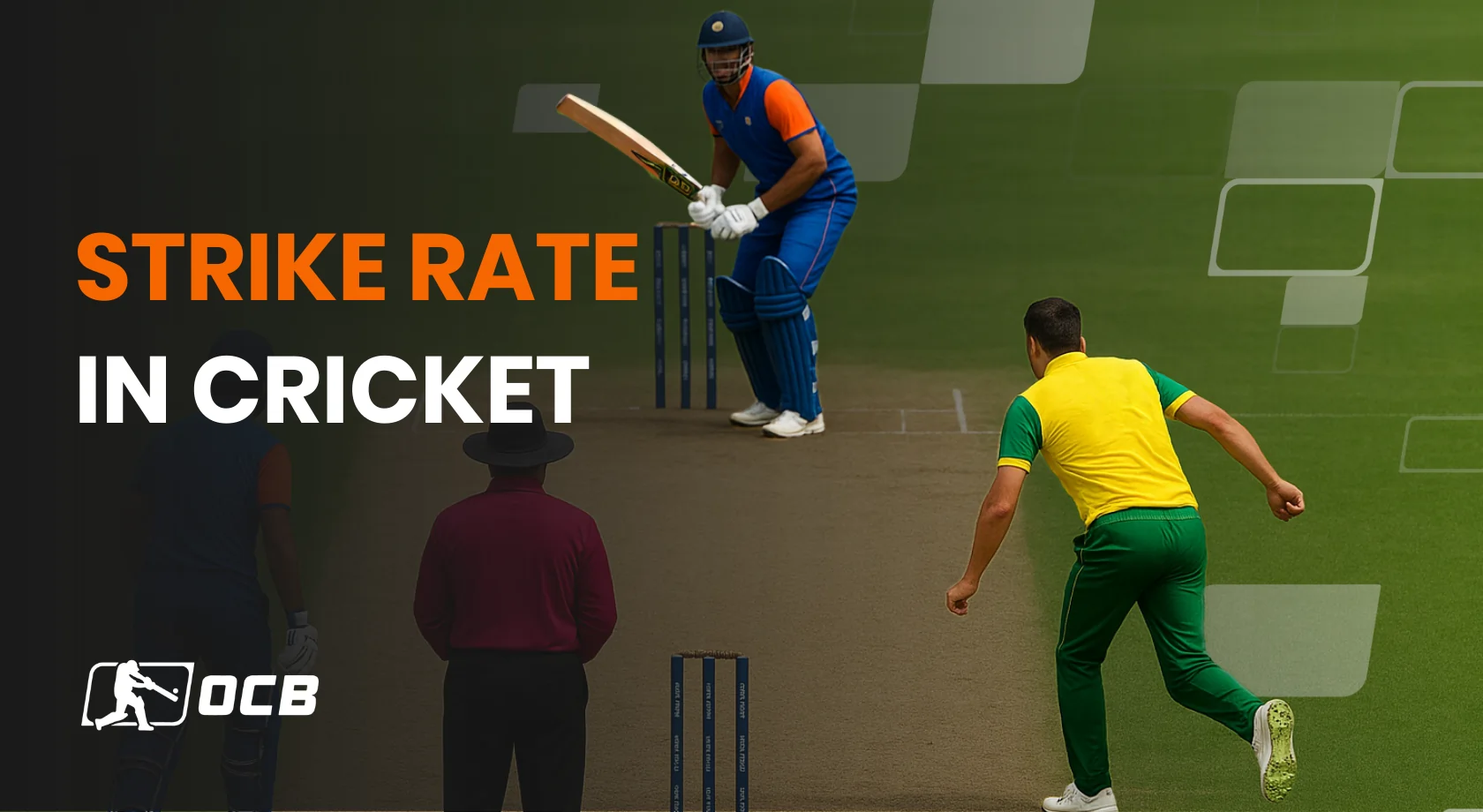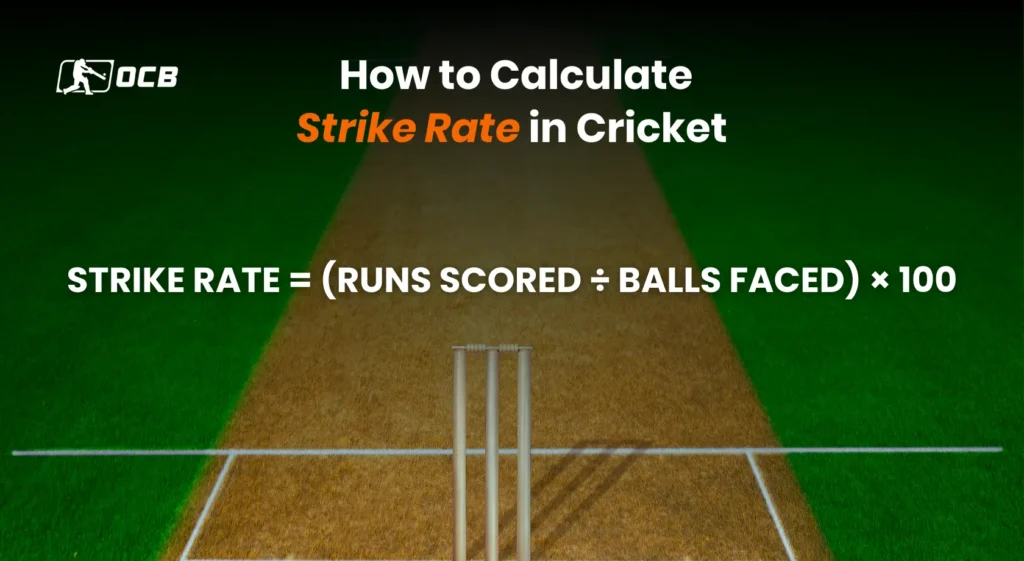What is Strike Rate in Cricket: An Essential Guide
Written by: OCB Editorial Team • 19.08.2025

For those who love cricket and want to understand the game on a deeper level, strike rate is one of the most important statistics you need to know. Whether you want to become a betting pro, or you just want to know the game better, learning about strike rate will give you a huge advantage.
If you've ever wondered how to calculate strike rate or wanted to know who holds the highest strike rate in cricket history, then this guide is for you. Knowing the finer details about what strike rate really means, can help you make better predictions, place smarter bets, and enjoy matches with greater insight.
In this article, we'll also highlight why strike rate matters in different formats such as Tests, ODIs, and T20s, and also discuss the all-time greats with the highest strike rates. Read on!
Strike Rate Meaning in Cricket
| Simply put, strike rate is a measurement of how quickly a player achieves results. For a batter, strike rate shows how many runs are scored per 100 balls faced. For a bowler, strike rate is how many balls are bowled per wicket taken. |
Why strike rate matters in modern cricket formats
Strike rate in cricket has become one of the most talked-about stats in the modern game. Why? Because cricket has evolved. Test cricket is still the traditional format, but the rise of ODIs and especially T20s means speed and impact matter more than ever.
A batter with a high strike rate can change a game in just a few overs. Imagine someone scoring 40 runs off 20 balls in a T20, that kind of explosive batting can swing momentum instantly. On the other hand, a bowler with a low strike rate means they take wickets regularly, keeping the opposition under pressure.
If you’re a cricket betting fan, knowing how strike rate influences the flow of a game helps you make better decisions. A batter with a consistently high strike rate in cricket is often a smart pick, while a bowler with a sharp strike rate can be the match winner.
How to Calculate Strike Rate in Cricket
So, batting strike rate is about scoring efficiency, while bowling strike rate is about wicket-taking efficiency. Both figures are key to understanding a player's impact, especially in today’s fast-paced formats. But how is strike rate calculated?
Once you understand what strike rate in cricket is, the next step is knowing how to calculate it. And the calculation is simple:

Batting Strike Rate Formula: (Runs / Balls Faced) × 100
The formula for batting strike rate is:
| Strike Rate = (Runs Scored ÷ Balls Faced) × 100 |
This tells you how many runs a batter scores per 100 balls. For example, if a batter scores 50 runs from 40 balls, their strike rate is: (50÷40)×100=125
This means they score 125 runs for every 100 balls they face, which is excellent for limited-overs cricket.
Bowling Strike Rate Formula: Balls Bowled / Wickets Taken
For bowlers, the formula is slightly different:
| Strike Rate = Balls Bowled ÷ Wickets Taken |
Here, the strike rate shows how many balls a bowler needs to bowl on average to take a wicket. For instance, if a bowler delivers 300 balls and takes 10 wickets, their strike rate is: 300÷10=30
This means they claim a wicket every 30 balls on average.
Example calculations for both batting and bowling
Let’s take real-world examples:
- Batting: Suppose Virat Kohli scores 85 runs off 90 balls in an ODI. His strike rate is (85 ÷ 90) × 100 = 94.4.
- Bowling: Suppose Jasprit Bumrah bowls 240 deliveries (40 overs) and takes 12 wickets. His strike rate is 240 ÷ 12 = 20.
These figures tell us Kohli played a steady innings, while Bumrah was lethal, striking every 20 balls.
What Our Experts Think of Strike Rate in Cricket
Our Cricket Analysist, Dhruv, provides his opinion into this important stat:
| “Strike rate is more than just a number. It shows how a player can change the flow of a match, whether by scoring quickly or taking wickets at crucial moments. If you're serious about betting, it’s a stat that should always be on your radar.” |
Strike Rate Benchmarks Across Formats
The importance of strike rate shifts across formats. A "good" strike rate for a batter in Test cricket might be seen as modest in T20s. Similarly, bowlers are judged differently across formats.
Test cricket: Ideal batting and bowling strike rates
In this format, patience and consistency matter most. Batting strike rates are usually lower, often between 40–60. A player striking at 50 in Tests is considered steady. Bowlers, meanwhile, aim for a strike rate around 50–60, meaning they take a wicket every 8–10 overs.
ODI cricket: Balanced strike rate expectations
ODIs are all about balance. Batting strike rates typically range between 75–90 for top players. Anything over 100 in an ODI is exceptional. For bowlers, a strike rate of around 30–40 is solid, meaning they take wickets every 5–7 overs.
T20 cricket: High-impact strike rate thresholds
This format is all about fireworks. Batting strike rates of 130–150 are normal, while the very best go over 160. Bowlers with a strike rate of 15–20 balls per wicket are game-changers.
So, when diving into Cricket Betting Tips, remember that context is everything: a strike rate of 75 might be brilliant in Tests, average in ODIs, and poor in T20s.

Join our cricket betting community
Follow us on social media to stay up to date!
Highest Strike Rates in Cricket History
Naturally, cricket fans are always curious about who tops the charts when it comes to things like who has the highest strike rate in cricket history. Records remind us how destructive or effective a player can be.
It is important to note, that these stats are correct at the time of publishing the lists, but the info is dynamic and can change as players' careers progress and new records are set.
Top 5 ODI batting strike rates (min 500 balls faced)
Based on current data, the top 5 highest batting strike rates in men's T20I cricket (with a minimum of 250 balls faced) belong to Abhishek Sharma (193.84), Kayron Stagno (177.29), Faisal Khan (173.43), Saber Zakhil (169.28), and Darius Visser (168.57).
In women's T20I cricket, with the same minimum qualification, the top 5 are led by Chloe Tryon (138.27), followed by Alyssa Healy (130.23), Deandra Dottin (125.37), Sophie Devine (125.16), and Danielle Wyatt (124.14).
Top 5 Test bowling strike rates (min 50 wickets)
The list of the best Test bowlers by strike rate includes legendary figures. For men's cricket, the all-time leader is George Lohmann, with a remarkable strike rate of 34.1, meaning he took a wicket every 34.1 balls. Other greats like Shane Bond and Dale Steyn are also on the list, demonstrating their ability to consistently take wickets.
On the women's side, data is less plentiful, but players like England's Betty Wilson and Julia Greenwood have exceptional career strike rates of 42.4 and 38.7 respectively, showing their effectiveness over their careers.
Notable T20 strike rate records
T20 cricket is defined by explosive batting, and the records prove it. For men, some of the highest career strike rates belong to batters like Sahil Chauhan, and Abhishek Sharma of India, who has a strike rate near 200. Players like Suryakumar Yadav are also notable for maintaining a consistently high strike rate (over 170) while scoring a significant volume of runs.
For women, Chloe Tryon and Deandra Dottin are among the most explosive batters. In T20Is, Dottin holds the record for the fastest century, achieved in just 38 balls, highlighting the format's aggressive nature.
Final Thoughts
So, now you know what is strike rate in cricket; essentially, the pace of runs for batters and the frequency of wickets for bowlers. When you understand the strike rate meaning in cricket and how to calculate strike rate, it offers you a real edge. Knowing who can score quickly or take wickets regularly helps you foresee match dynamics.
As we've seen, cricket is a game of numbers and passion. Use stats like strike rate smartly to enjoy the game more deeply and make informed betting decisions.
You can browse more of our in-depth Cricket Guides or follow our Cricket Blog, for more informative and helpful insights.
FAQs
It shows how quickly a batter scores runs (runs per 100 balls) or how often a bowler takes wickets (balls per wicket).
Divide runs scored by balls faced, then multiply by 100.
Batting strike rate measures scoring speed, while bowling strike rate measures wicket-taking speed.
At the time of publishing, among men, Abhishek Sharma holds the top spot at 193.84. On the women’s side, Chloe Tryon leads with a strike rate of 138.27.
It indicates impact: it helps you identify batters who score fast and bowlers who take wickets swiftly, both vital for predicting outcomes.
Sources: espncricinfo.com, wikipedia.